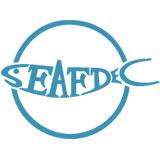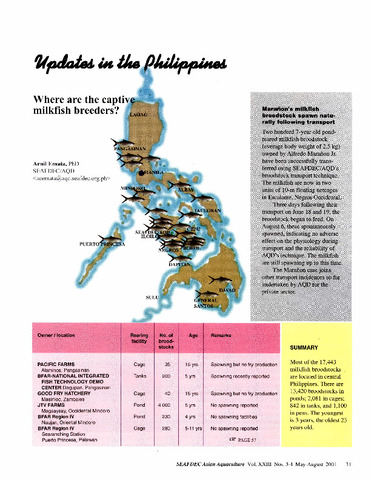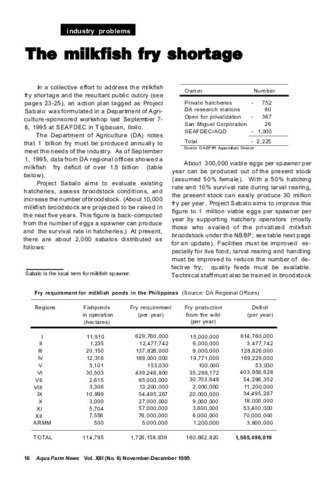| dc.contributor.author | Villaluz, Antonio C. | |
| dc.contributor.author | Villaver, William R. | |
| dc.contributor.author | Salde, Ruby J. | |
| dc.date.accessioned | 2012-02-20T05:26:17Z | |
| dc.date.available | 2012-02-20T05:26:17Z | |
| dc.date.issued | 1983 | |
| dc.identifier.citation | Villaluz, A. C., Villaver, W. R., & Salde, R. J. (1983). Milkfish fry and fingerling industry of the Philippines: methods and practices. (Technical Report No. 9) (2nd ed.). Tigbauan, Iloilo, Philippines: Aquaculture Department, Southeast Asian Fisheries Development Center. | en |
| dc.identifier.issn | 0115-4710 | |
| dc.identifier.uri | http://hdl.handle.net/10862/859 | |
| dc.description | 2nd Edition. | en |
| dc.description.abstract | Milkfish fry catch from Philippine waters can still be increased. Intensified collections in traditional fry grounds and exploitation of new areas may lead to a reduction of adult stock and the possible collapse of the milkfish fry fishery. The implementation of rational conservation and management measures are of immediate concern not only to increase the productivity and number of fry grounds but also to conserve this important aquatic resource.
The present methods of catching milkfish fry involve fry filtration by mobile or stationary devices. The design, construction, area and time of operation of the gears are primarily dictated by the bottom topography of the fry grounds, wind direction, local current patterns and tidal fluctuations.
Catching, handling, storage and transport activities expose the fish to undue stress which contribute to poor survival. The simple method of lowering the salinity of the water medium considerably reduces mortality.
High mortality in nursery ponds has aggravated the seed shortage problem of the milkfish industry. The development of an efficient mass-production technology in rearing milkfish fry to fingerlings and in stunting fingerlings for longer periods could offer the solution not only in meeting the requirements for milkfish seed but also provide part of the fry requirements of other countries in the region. | en |
| dc.description.sponsorship | This study was partially supported by the Canadian International Development Research Centre. | en |
| dc.format.extent | ii, 81 p. : ill. | en |
| dc.language.iso | en | en |
| dc.publisher | Aquaculture Department, Southeast Asian Fisheries Development Center | en |
| dc.publisher | International Development Research Centre | en |
| dc.relation.ispartofseries | Technical report / SEAFDEC Aquaculture Department; No. 9 | en |
| dc.subject | Chanos chanos | en |
| dc.subject | milkfish | en |
| dc.subject | Philippines | en |
| dc.subject.lcsh | Milkfish -- Fry -- Philippines | en |
| dc.subject.lcsh | Fry trade -- Philippines | en |
| dc.title | Milkfish fry and fingerling industry of the Philippines: methods and practices | en |
| dc.type | Technical Report | en |
| dc.subject.asfa | aquaculture techniques | en |
| dc.subject.asfa | fish culture | en |
| dc.subject.asfa | fish industry | en |
| dc.subject.asfa | fishing gear | en |
| dc.subject.asfa | seed collection | en |
| dc.subject.asfa | storage | en |
| dc.subject.asfa | transport | en |
| dc.subject.scientificName | Chanos chanos | |



